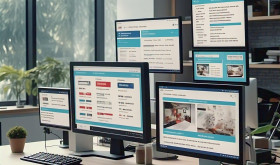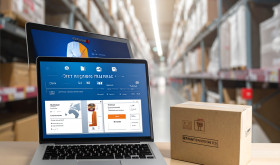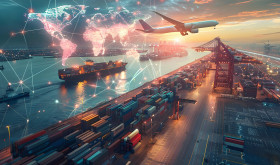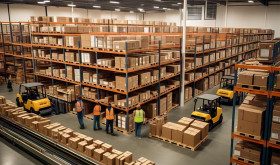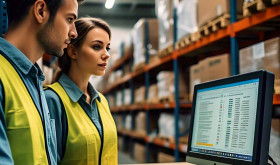
Sustainability isn’t just a trendy business term anymore—it’s now a key part of how companies plan their strategies. As people worry more about the environment, rules get stricter, and customers expect different things, businesses are rethinking how they manage their supply chains. Green logistics leads this change, aiming to cut down on the environmental impact of moving, storing, and delivering goods.
The transport management system plays a crucial role in making green logistics work. This digital tool helps to find the best routes, keep an eye on fuel use, and make freight operations run. As companies try to reach their goals for reducing carbon emissions, TMS platforms have become essential. They help businesses strike a balance between being efficient and taking care of the environment.
The Rising Importance of Green Logistics
The logistics industry has a significant impact on global emissions. The International Energy Agency reports that freight transport is responsible for about 8% of global CO₂ emissions, and this number will increase as e-commerce and global trade grow. In response, governments and organizations have launched initiatives like the Paris Agreement, carbon taxes, and emission reporting standards.
Green logistics tries to address these issues by:
- Cutting carbon emissions from freight and transport
- Boosting energy efficiency in supply chains
- Using eco-friendly packaging and warehousing methods
- Applying technology to create smarter, cleaner operations
Technology-driven platforms, especially the transport management system, have a key role to play in this effort.
How Transport Management Systems Help Sustainability
A transport management system is not just a logistics tool. It has an influence on sustainability. Here’s how a transport management system helps create greener supply chains:
- Route Optimisation to Lower Emissions
A transport management system uses smart algorithms to find the best delivery routes. By cutting down travel distance and steering clear of traffic jams, companies can reduce fuel use and CO₂ output. For example, a big FMCG company cut its fleet’s emissions by 15% when it started to use route optimisation through its transport management system.
- Load Consolidation and Capacity Utilisation
Trucks that aren’t full waste gas and put out extra carbon. A transport management system helps companies fill trucks to the max by putting loads together. This cuts down on trips and makes the best use of containers—resulting in lower costs and less harm to the environment.
- Working with Electric and Other Clean Fuel Fleets
Many businesses are switching to electric vehicles (EVs) and fleets that run on biofuel. New transport management systems work well with these fleets, helping dispatchers handle charging times, how far EVs can go, and the best routes for them.
- Real-time Freight Visibility
IoT-powered tracking in the transport management system gives companies a real-time view of shipment progress. This lets them make smart choices to cut down on wasted miles, idle time, and inefficient routes—all of which lower emissions.
- Sustainability Reporting and Compliance
Transport management systems now offer tools to track and report greenhouse gas emissions, fuel use, and sustainability metrics. These insights help businesses meet regulations and back up their ESG (Environmental, Social, Governance) reports.
The Business Case for Green Logistics
Many firms see the move to sustainable logistics as more than just following rules—it’s about staying competitive. Key perks include:
- Cost Savings: Lower fuel use and fewer empty miles cut down operating costs.
- Brand Reputation: More and more customers like brands that care about the environment. Green logistics boosts corporate image.
- Risk Mitigation: Companies that stay ahead of rules avoid fines and disruptions.
- Innovation Advantage: Companies that adopt transport management system-driven sustainability get better at operations, leaving rivals behind.
A logistics company in Southeast Asia used a transport management system to combine deliveries for many clients. This cut yearly CO₂ emissions by over 3,000 tons and saved millions on fuel.
Challenges in Implementing Green Logistics
Even though it has benefits, green logistics faces some hurdles:
- High Initial Investment: Switching to electric fleets, putting in IoT devices, and upgrading to advanced TMS platforms needs a lot of money up front.
- Complex Integration: Adding new tech to old systems can take up a lot of resources.
- Change Management: Logistics teams often need to learn new skills to get the most out of new digital tools.
- Regulatory Uncertainty: Different countries have different rules about emissions, which makes it hard for global supply chains to follow all the rules.
Even so, companies know that doing nothing costs more—it can hurt their reputation, make them less efficient, and lead to fines—than dealing with these challenges.
Future Trends in Green Logistics and Transport Management System
As sustainability shifts from a “nice-to-have” to a “must-have,” several trends will shape the future of logistics:
- AI-Enhanced Transport Management System
Artificial intelligence will make transport management systems smarter. This will enable predictions for route planning, automate load matching, and create advanced models for carbon footprints.
- Blockchain for Transparency
Companies will use blockchain to check sustainable sourcing and provide carbon reports that can’t be tampered with across the logistics ecosystem.
- Greater EV Integration
As electric fleets grow, transport management system platforms will add more EV-specific features. These will include routing for electric vehicles, mapping of charging stations, and tracking of maintenance needs.
- Collaborative Transport Networks
Businesses will team up on shared transport management system platforms to work together on freight. This will cut down on empty miles and make the best use of shared resources across industries.
- Circular Supply Chains
Transport management systems will have an impact on reverse logistics—helping to manage returns, recycling, and repurposing to close the loop on waste.
Case Study: A Transport Management System-Driven Sustainability Success
A major pharmaceutical distributor faced challenges with increasing transport costs and sustainability pressures. By using a cloud-based transport management system, the company:
- Cut yearly fuel use by 12% through better routing.
- Reached 98% on-time deliveries while cutting emissions.
- Combined deliveries to cut empty miles by 20%.
- Got full ESG reporting to show sustainability metrics to stakeholders.
This case highlights that a transport management system is more than a logistics tool. It has a key role in driving green changes.
Conclusion
Going green and using eco-friendly logistics are now must-dos. They’re key plans for companies that want to do well in a world with limited resources, new rules, and people who care about the planet. The transport management system is at the heart of this shift. It’s a platform that brings together better routes, fuller loads, managing electric trucks, seeing what’s happening right now, and making reports to follow rules—all in one powerful package.
By embracing transport management system-driven sustainability, companies can unlock a win-win: reducing their environmental footprint while driving cost savings, efficiency, and competitive advantage.
The logistics landscape of tomorrow isn’t focused on speeding up deliveries—it’s about transporting items in a more intelligent, eco-friendly, and sustainable way.


